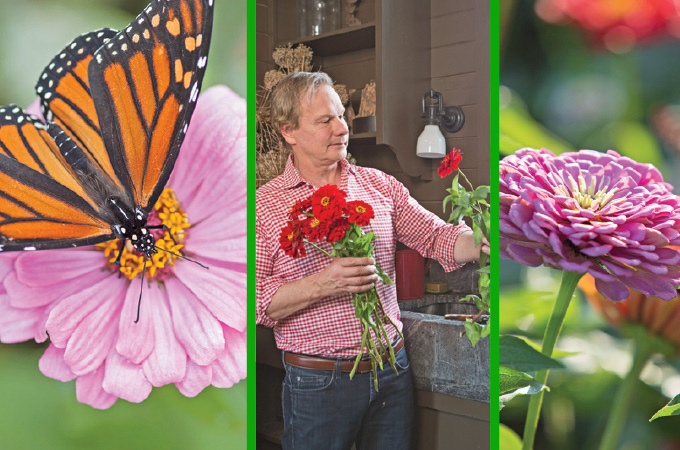If your garden is anything like mine, it’s starting to show a little wear and tear, responding to the extremes of summer. The bloom is off my roses—literally—and most other flowers in the garden are a little crispy around the edges. Everything, that is, except the zinnias. Zinnias are one of those rare flowers that laugh in the face of heat and drought and put on a colorful, glorious display. Their large, petaled faces come in all shades of pink, yellow, orange, red and purple, and the pigments are rich and clear.
This bold annual has been in cultivation for hundreds of years and originates in the southwestern United States, Mexico and Central America, which explains why it’s such a great performer in hot, sunny locations. Flowers last for such a long time in pristine condition that zinnias are sometimes known by the common name ‘Youth and Old Age.’ They can be anywhere from 6 inches tall to an impressive 4 feet! And butterflies? Zinnias attract them like moths to a flame.
You can start zinnias by seed indoors four to six weeks before the last average frost date for your zone, or wait and sow them directly in the garden when the weather warms. It’s an incredibly easy plant to grow from seed—great for children and beginning gardeners—or just pick up a six-pack. In fact, I plant zinnia seed directly in the soil successively every two weeks in patches at Moss Mountain Farm (Zone 8a) through August to ensure plenty of blooms in early fall and through October.
The only disease issues to watch out for are leaf spot and powdery mildew. The main culprits are too much water, high humidity and poor air circulation. During the height of summer, water at the base of the plants so leaves remain dry, and let the soil dry between waterings. Discard brown, fallen leaves, and space plants with enough room for good air circulation. If necessary, treat affected plants with a fungicide such as Neem oil.
some of my favorite varieties:
>> State Fair: The classic zinnia and my gold standard variety, these plants reach about 2.5 feet tall, and flower heads are an amazing 5 to 6 inches across.
>> Thumbelina: A true dwarf at only 4 to 6 inches tall, it’s a great selection for the front of a border or as part of a container display.
>> Benary’s Giant: The go-to zinnia for the cut flower industry, it has luscious, dahlia-type flower heads and extra-sturdy stems. Plants reach about 3 feet tall with blooms 5 inches wide.
>> Magellan: Considered a dwarf variety, it reaches 12 to 14 inches tall with double flowers. This variety has a tidy, uniform growth habit, so it’s perfect in containers and window boxes.
>> Profusion: Exceptional disease resistance and a compact, uniform habit make this another popular variety. Plants reach about 18 inches tall and can spread to about 18 inches wide. A great selection for planting en masse.
>> Zinnia angustifolia: Also known as creeping zinnia, this plant features narrow leaves and often is used at the front of a border, reaching about 12 inches tall.
>> Cut and Come Again: These 3-foot-tall plants feature double blooms about 2.5 inches wide. And as the name suggests, they make great cutting flowers, producing new flower buds throughout the growing season.
P. Allen Smith is an author, conservationist and TV host of Garden Home on PBS and Garden Style (check your local listings). He uses his Arkansas home, Moss Mountain Farm, to promote the local-food movement, organic gardening and the preservation of heritage poultry. For tours of the farm, visit pallensmith.com/tours.
